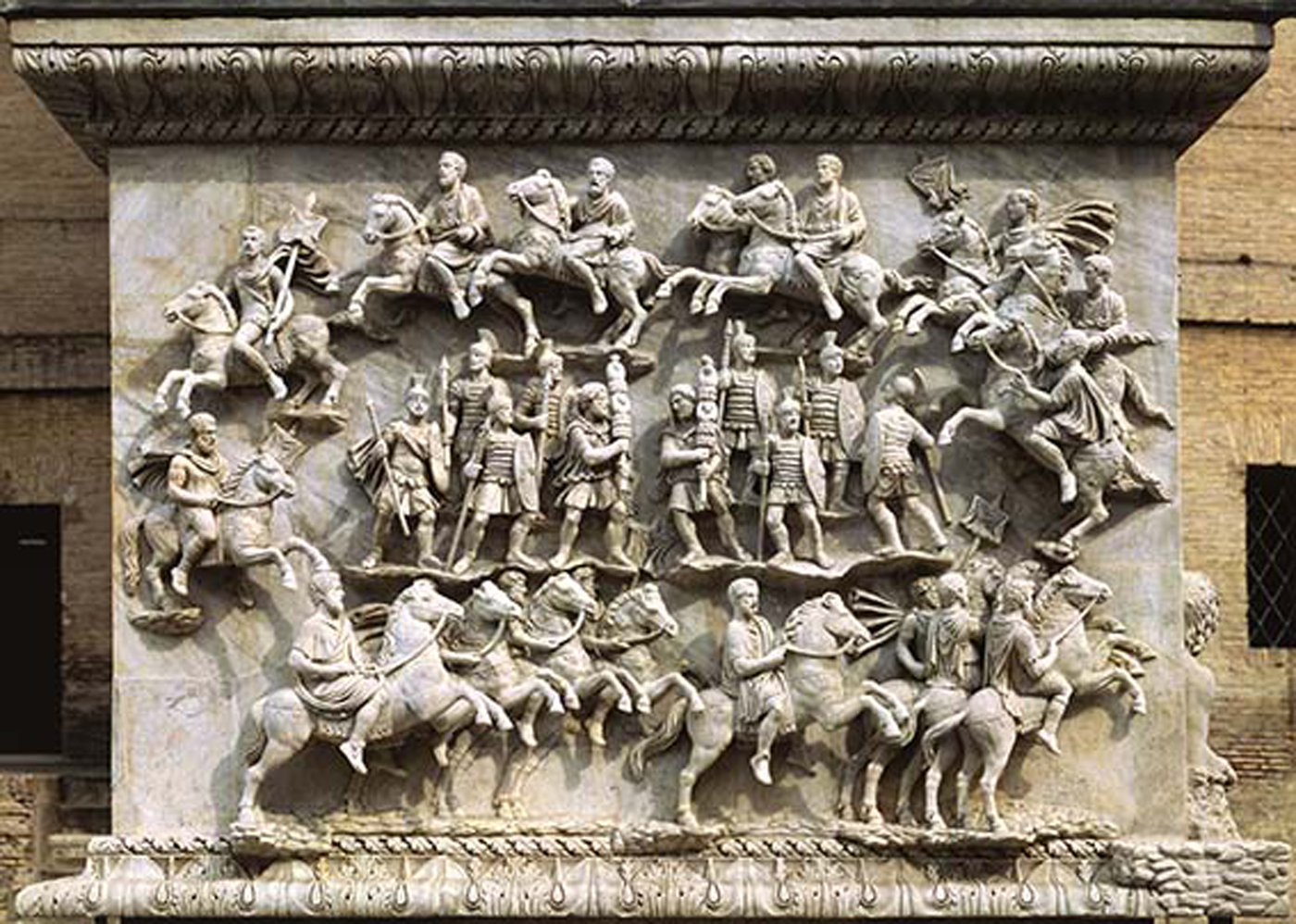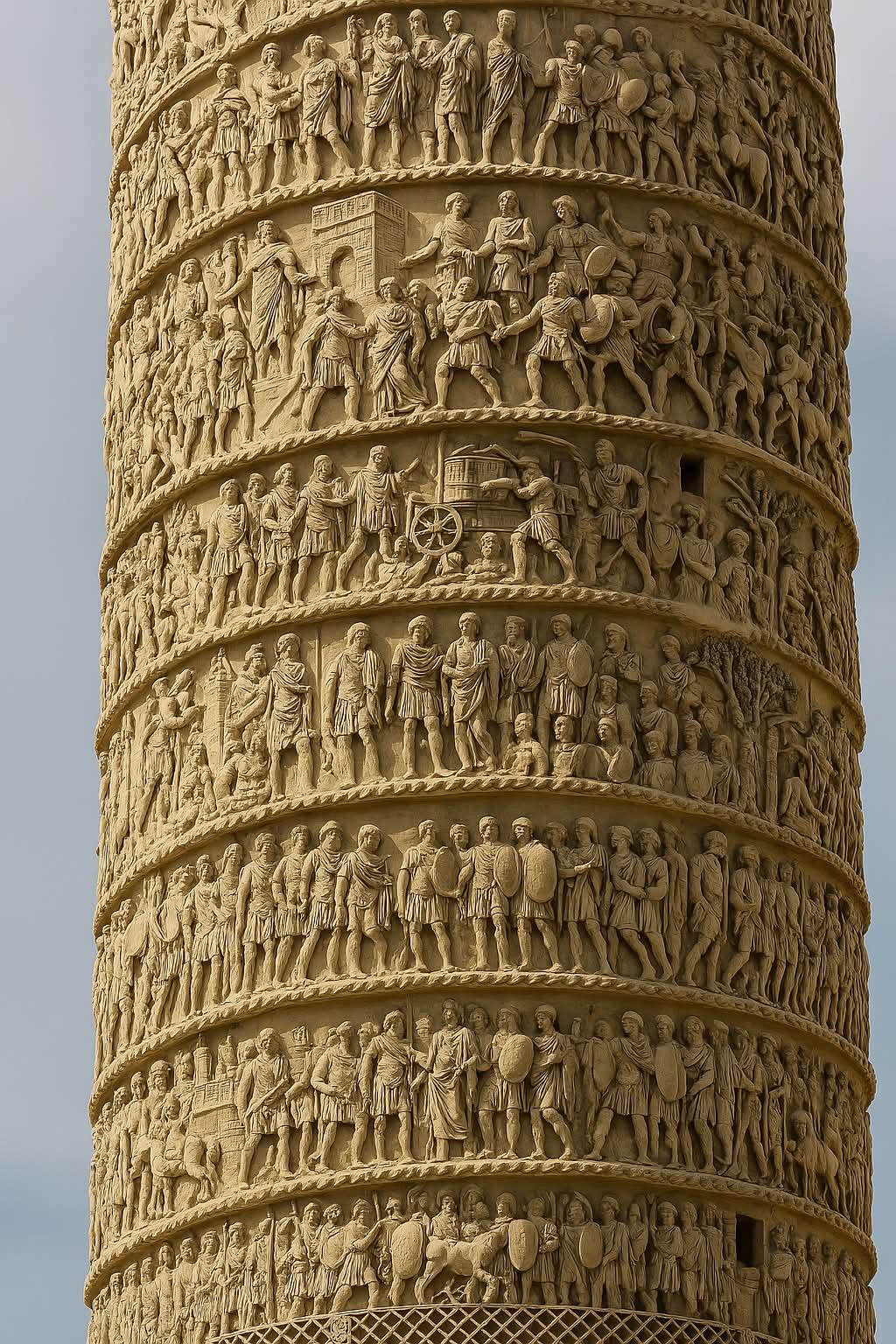Rising proudly in the heart of Rome’s Piazza Colonna, the Column of Marcus Aurelius and Faustina stands as one of the city’s most majestic symbols of imperial power and artistic mastery. Built around 180 CE, this towering monument is believed to have been commissioned by Emperor Commodus to honor his deified parents—Marcus Aurelius, the philosopher-king of Rome, and Empress Faustina the Younger.
A Monumental Legacy of Imperial Grandeur

Modeled after the legendary Trajan’s Column, the Column of Marcus Aurelius reaches an impressive 39 meters (128 feet) above the ground, its spiraling reliefs intricately carved to immortalize the emperor’s military victories along the Danube frontier. These scenes vividly depict the campaigns against the Quadi and Marcomanni tribes between 172 and 175 CE, showcasing not only Rome’s military dominance but also the emperor’s stoic leadership amid adversity.
Historians note that the column originally stood even taller. According to 4th-century CE documents, the entire structure—including its now-lost statue of Marcus Aurelius—once reached a staggering 51.95 meters (175 Roman feet), making it one of the tallest commemorative columns in the ancient world.
Engineering Brilliance Hidden in Stone

Beyond its artistic splendor, the Column of Marcus Aurelius represents a triumph of Roman engineering and design. Crafted from Carrara marble, the structure consists of 28 massive cylindrical drums, each meticulously carved before being hoisted into place—a logistical feat that continues to amaze modern architects.
Running through the center is a hollow spiral staircase made of 190 steps, allowing visitors (and once, imperial guards and priests) to ascend to the summit. From there, ancient spectators could take in a panoramic view of the imperial city—a vantage point symbolically connecting the emperor’s earthly achievements to the divine realm above.
The base of the monument, however, hides its own secrets. Extending nearly 7 meters (23 feet) below ground, it anchors the massive column and has long fueled speculation among archaeologists. Some believe these subterranean chambers might once have held dedicatory inscriptions, relics, or imperial offerings—perhaps even remnants of a temple once dedicated to the deified emperor and empress.
From Ancient Majesty to Modern Marvel

Originally, the column was crowned with a bronze statue of Marcus Aurelius, likely depicting him in military attire or divine form. During the Christianization of Rome, this figure was replaced in 1589 by a statue of Saint Paul, commissioned by Pope Sixtus V, symbolically transforming the monument from a pagan relic into a Christian emblem of endurance and faith.
The column’s detailed carvings remain a masterpiece of Roman narrative art. Unlike Trajan’s Column, which celebrated conquest with idealized clarity, the reliefs of Marcus Aurelius display a darker, more emotional tone—reflecting the hardship, suffering, and moral complexity of late imperial warfare. Scenes of mercy, diplomacy, and divine intervention punctuate the chaotic battle depictions, offering insight into the emperor’s philosophical worldview influenced by Stoicism.
The Emperor and the Philosopher

Marcus Aurelius, remembered as one of Rome’s most virtuous rulers, was not merely a conqueror but a thinker. His philosophical writings, compiled in the Meditations, reveal a ruler deeply concerned with duty, ethics, and the fleeting nature of power. The column’s design and inscriptions echo this theme—suggesting that victory, while grand, was only one aspect of an emperor’s legacy.
His wife, Empress Faustina the Younger, played a significant role in imperial politics and social reform, earning deification after her death. Their son Commodus’ decision to dedicate this monument to both parents demonstrates not only filial devotion but also a deliberate effort to legitimize his own reign through divine ancestry.
Echoes of a Lost Temple
Historical accounts suggest that the column was once part of a larger temple complex, possibly dedicated to the deified Marcus Aurelius and Faustina. Scholars believe it may have stood near the Temple of the Deified Hadrian or along the Via Flaminia, serving as a sacred axis connecting the spiritual and political heart of Rome.
Fragments of architectural remains discovered nearby lend weight to this theory. However, centuries of urban development have obscured much of the original context, leaving only hints of the column’s former glory beneath the bustling Piazza Colonna.
A Living Monument in the Modern City
Today, the Column of Marcus Aurelius continues to dominate the Roman skyline—its weathered reliefs still visible to those who wander the square between the Palazzo Chigi and the Galleria Alberto Sordi. Though access to the interior staircase is restricted, digital reconstructions allow visitors to experience the ascent virtually, revealing every detail of the reliefs that spiral skyward like a marble chronicle.
The column remains a powerful reminder of Rome’s enduring dialogue between art, politics, and philosophy. Each carved soldier, river god, and celestial figure tells a fragment of a greater story—one that binds history’s greatest empire to the timeless human pursuit of honor, remembrance, and meaning.
As archaeologists continue to study the base and nearby structures, new technologies such as ground-penetrating radar promise to uncover further secrets buried beneath the ancient pavement. Perhaps one day, Rome will reveal whether more truly lies “beneath the surface” of this monumental masterpiece.
A Testament to Eternal Rome
The Column of Marcus Aurelius and Faustina is far more than stone and marble—it is a narrative carved in relief, a monument to love, loss, and legacy. Its presence bridges nearly two millennia of history, standing resilient amid the modern pulse of the Eternal City.
Visitors who pause before it today stand in the same square where emperors, popes, and pilgrims once gathered—each generation interpreting its spiraling story anew. And as sunlight touches the worn marble, the column continues to speak, quietly yet powerfully, of the imperial grandeur and human spirit that built Rome itself.
Sources:
- Musei Capitolini – Records of the Column of Marcus Aurelius (2024)
- UNESCO World Heritage: Roman Imperial Monuments of the Campus Martius
- Journal of Roman Archaeology – “Commodus and the Deification of Marcus Aurelius and Faustina” (2023)
- British School at Rome – “Engineering Marvels of the Imperial Columns”